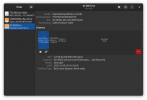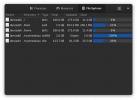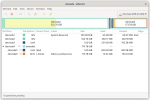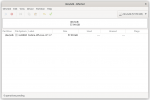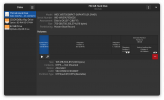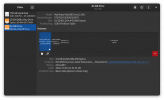AlexOceanic
Member
Hi All
I'm trying to remove Fedora 36 from a HDD partition and install 37 from a USB ISO over it (not upgrade from within 36) and and am having some tribbles...
Background
- 750 GB HDD with Win 7 resized to 550 GB and installed dual booting Fedora 36 from USB ISO successfully on remaining 200 GB
(all installs were/are to be dual booting for now)
- Overwrote Fed 36/ 200 GB partition when installing Kali (also dual boot) which I used without issue for several months
- Needed to update NVIDIA GPU driver to enable fast rendering in Blender and messed up the install
- Decided I should move back to Fedora as a noob who wanted to install non Kali software and discovered I couldn't boot from USB anymore and encountered a "ldlinux.c32 missing error" each time I tried (BIOS settings were still set to boot USB first etc)
- I tried rewriting the ISO's (although the Fed 36 ISO I used previously had been fine) and the direct "cp" method and an ISO from Balena-Etcher stopped the error message but it still skipped straight to the GRUB/Kali boot screen rather than booting from USB just prior to this stage.
- After various solutions failed, I triple checked the BIOS settings and it seemed that bringing the "USB CD" and "USB FDD" up the boot order above the "HDD" entries and running an ISO of a boot repair utility actually allowed the boot repair utility to boot from USB.
- I immediately rebooted with the Fedora 36 ISO and it worked for some reason
- I've had a nightmare installing a legacy NVIDIA driver for my GT550 (Optimus) where I tried installing the generic NVIDIA driver (notrealising my GPU was out of support for this driver) and even after extensive help from forum members t delete the old drivers and install the now correctly identified drivers has failed
- Each GPU driver install attempt created a new kernel/boot option on the GRUB2 menu and the latest one broke the wifi and ran in low resolution mode
- At this point (and after being advised to move to Fedora 37) I thought it might be simpler to overwrite the Fed 36 partition and install Fed 37 but I've encountered the issue where it won't boot from USB again,even after repeating the steps which appeared to be a workaround beforehand.
- I tried going into the GRUB2 command prompt (pressing c on the GRUB2 bootloader menu) to force it to boot from USB and managed to follow instructions for GRUB1 rather stupidly but I managed to the set the root back to the correct partition and Fed 36 runs again now
- I had another go at identifying the correct root to set (which I finally identified as "hd1") but I couldn't see the "mdosX" part listed like the other hd0 entries ranging from msdos1 to 6 and when I set root to "hd1" it couldn't find /efi/boot/grubx64.efi when running the "chainloader" command
- I managed to boot the boot repair utility again a moment ago (simply moved HDD BD to bottom of boot order?!?) but the Fed 37 ISO didin't boot afterwards this time.
- I inserted the Fed 37 ISO whilst running the boot repair disk and saved the log report this time which seems to have found some issues with the ISO boot targets and MBR being overlapped on the first 32 blocks.
Are there any kind souls out there who might review the attached boot report log and help me resolve these errors please?
(And yes I know I shouldn't have used Kali to start with and should've checked the GPU driver/GRUB version installed etc but non of us are perfect eh)
Many thanks
Alex
(I tried pasting the boot report output below in case anyone didn't want to open this .txt file but hit the 30,000 character limit per post - happy to paste it in another thread and link to it if required and that's acceptable)
I'm trying to remove Fedora 36 from a HDD partition and install 37 from a USB ISO over it (not upgrade from within 36) and and am having some tribbles...
Background
- 750 GB HDD with Win 7 resized to 550 GB and installed dual booting Fedora 36 from USB ISO successfully on remaining 200 GB
(all installs were/are to be dual booting for now)
- Overwrote Fed 36/ 200 GB partition when installing Kali (also dual boot) which I used without issue for several months
- Needed to update NVIDIA GPU driver to enable fast rendering in Blender and messed up the install
- Decided I should move back to Fedora as a noob who wanted to install non Kali software and discovered I couldn't boot from USB anymore and encountered a "ldlinux.c32 missing error" each time I tried (BIOS settings were still set to boot USB first etc)
- I tried rewriting the ISO's (although the Fed 36 ISO I used previously had been fine) and the direct "cp" method and an ISO from Balena-Etcher stopped the error message but it still skipped straight to the GRUB/Kali boot screen rather than booting from USB just prior to this stage.
- After various solutions failed, I triple checked the BIOS settings and it seemed that bringing the "USB CD" and "USB FDD" up the boot order above the "HDD" entries and running an ISO of a boot repair utility actually allowed the boot repair utility to boot from USB.
- I immediately rebooted with the Fedora 36 ISO and it worked for some reason
- I've had a nightmare installing a legacy NVIDIA driver for my GT550 (Optimus) where I tried installing the generic NVIDIA driver (notrealising my GPU was out of support for this driver) and even after extensive help from forum members t delete the old drivers and install the now correctly identified drivers has failed
- Each GPU driver install attempt created a new kernel/boot option on the GRUB2 menu and the latest one broke the wifi and ran in low resolution mode
- At this point (and after being advised to move to Fedora 37) I thought it might be simpler to overwrite the Fed 36 partition and install Fed 37 but I've encountered the issue where it won't boot from USB again,even after repeating the steps which appeared to be a workaround beforehand.
- I tried going into the GRUB2 command prompt (pressing c on the GRUB2 bootloader menu) to force it to boot from USB and managed to follow instructions for GRUB1 rather stupidly but I managed to the set the root back to the correct partition and Fed 36 runs again now
- I had another go at identifying the correct root to set (which I finally identified as "hd1") but I couldn't see the "mdosX" part listed like the other hd0 entries ranging from msdos1 to 6 and when I set root to "hd1" it couldn't find /efi/boot/grubx64.efi when running the "chainloader" command
- I managed to boot the boot repair utility again a moment ago (simply moved HDD BD to bottom of boot order?!?) but the Fed 37 ISO didin't boot afterwards this time.
- I inserted the Fed 37 ISO whilst running the boot repair disk and saved the log report this time which seems to have found some issues with the ISO boot targets and MBR being overlapped on the first 32 blocks.
Are there any kind souls out there who might review the attached boot report log and help me resolve these errors please?
(And yes I know I shouldn't have used Kali to start with and should've checked the GPU driver/GRUB version installed etc but non of us are perfect eh)
Many thanks
Alex
(I tried pasting the boot report output below in case anyone didn't want to open this .txt file but hit the 30,000 character limit per post - happy to paste it in another thread and link to it if required and that's acceptable)

